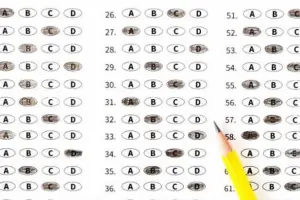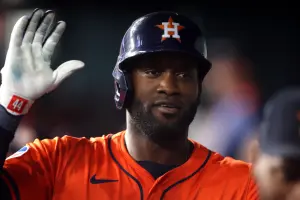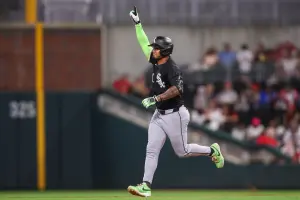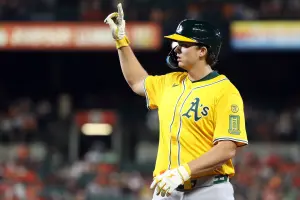
(*) SPECULATOR: 2nd-half rebound candidates
The following article appeared in the July 10 edition of Sports Weekly.
It doesn’t take much analytical insight to predict that a Mike Trout or Stephen Strasburg is a good play for the second half of the season. A somewhat more interesting exercise is to provide a list of players who we think will see their fortunes change over the rest of the season. That’s our focus this week: a full lineup’s worth of second-half rebound candidates. Warning: some of these candidates haven’t given us much reason for hope, other than having a longer-term historical track record of better performance. (Note: for all 1st/2nd half split data, we will use June 30 as the cutoff point.)
Arizona catcher Miguel Montero was so inept at the plate in April and May that he was likely dropped in a lot of mixed leagues. If he’s still available, he is now worth a look: his numbers for the past 31 days (3 HR, .278 BA, .775 OPS) are quite reasonable, and much more in line with his traditional levels. Whatever was bothering him earlier this season seems to have abated, so he is in position to take a run at his typical 15-18 home run season, giving you three more months of value in the process.
Minnesota first baseman Justin Morneau hasn’t been productive at the plate for a year and a half now. Is it time to give up on him ever regaining those levels? Maybe not just yet; as there are some flickers of life in his recent performance. His power numbers have ticked up over the past month (4 HR). Morneau’s line drive rate has been creeping upward month-over-month all season, while he’s maintained consistent strike zone skills. A full return to his last-decade peak production isn’t likely, but Morneau’s second half should be a good bit better than his first.
Milwaukee second baseman Rickie Weeks has established himself as a streaky hitter. Last season, he suffered an awful first half (6 HR, 6 SB, .183 BA in 268 AB) before bouncing back with a much more credible second half (15 HR, 10 SB, .269 BA in 320 AB). His 2013 campaign has had the same pattern, except he got hot a little earlier: following two sub-.200 batting average months in April and May, he hit 5 home runs with a .355 batting average this June. In general, first/second half splits aren’t predictive year-over-year, but Weeks’ track record of extreme performance splits gives us optimism that he could be doing it again.
Kansas City third baseman Mike Moustakas seemingly established himself in 2012 as a hitter with questionable batting average but legitimate power. At only 24 years old entering 2013, it seemed reasonable to expect at least an incremental step forward. Instead, Moustakas has regressed in the first half (5 HR, .215 BA). Team-wide hitting struggles in Kansas City led to the hiring of George Brett as hitting coach last month, and there are some notable (albeit small sample size) changes in Moustakas’ approach since. He is concurrently making more contact, taking a few more walks, and starting to hit more fly balls. Teammate Eric Hosmer has already shown improvement under Brett’s tutelage, and Moustakas’ resurgence may not be far behind.
Angels shortstop Erick Aybar is perhaps our most straightforward rebound candidate: his first half (.284 BA, 3 HR, 4 SB) was hampered by heel and groin injuries, both of which had a strong negative impact on his speed game. He has gotten back to running in recent weeks, a good indicator that those injuries are indeed behind him. When he is healthy, Aybar is a good bet for a .300 batting average and 15 stolen bases in half a season, and that’s exactly what we expect to see over the balance of this year.
Angels outfielder Josh Hamilton has been a colossal disappointment for his first few months in Anaheim, but has picked up his production recently, including a pair of game-winning hits last week. Much has been made of Hamilton’s struggles since quitting chewing tobacco last summer, and coincidentally there are recent reports out of Anaheim that Hamilton is back to using the chew. It’s too facile a conclusion to draw that “Hamilton + tobacco = good,” even though that will be the storyline if this recent resurgence takes root. The simple fact is that Hamilton has a track record of being a much better player than he showed us in the first half, and he’s likely to move back toward a more normal Hamilton stat line from this point on.
Atlanta outfielder Jason Heyward had his first half interrupted by an emergency appendectomy that cost him nearly four weeks. He had been struggling mightily before the DL stint, and the weight of that pre-surgery stat line is being felt. But he has been much more productive since his return (.264 BA, 5 HR, .761 OPS over 174 AB) in all categories except stolen bases—and that dip probably isn’t surprising after major surgery. He did steal his first base since the surgery last week, perhaps yet another sign that he is getting closer to fully healthy and primed for a second-half breakout.
Miami outfielder Giancarlo Stanton's combination injury plus lack of production has wrecked more than a few fantasy teams this year. But all hope isn’t lost for Stanton owners. In particular, the Marlins’ lineup, while still anemic, is starting to fill in a little bit. Logan Morrison, Chris Coghlan, and Marcell Ozuna provide at least some complementary pieces, and while Stanton’s frustrations with the Marlins are well-documented, at this point the interests of player and club may be aligned: if Stanton wants out of Miami and the Marlins want to maximize their trade return, everyone will benefit from a big second half. A year ago, Stanton hit 19 second-half home runs despite missing almost all of July. Give him a full three months worth of AB this year, and 20-25 home runs are well within reach.
Arizona starter Ian Kennedy has an ugly 5.16 ERA, which is well out of line with his career levels. He also hasn’t pitched nearly that badly. A big portion of that ERA damage came in one 10-run pounding at the hands of the Cardinals. All in all, Kennedy’s skills are right in line what we have seen from him in the past; it’s just that the results haven’t followed the skills. As such, Kennedy is a good bet for a high-3.00 ERA over the balance of the season.
Tampa closer Fernando Rodney has had a bumpy follow-up to his record-setting 2012 campaign. Manager Joe Maddon stubbornly stuck with Rodney when he was struggling earlier in the season, particularly in a May stretch where he was scored upon in four of five outings. Since then, he has been unscored upon in 13 of 15 outings, notching 10 saves in that stretch. So, while Rodney’s 4.17 ERA may be 3.5 runs higher than it was last year, he still looks like a solid saves source.
Next week: Trade deadline speculation, part 1.
The Speculator is not designed to makes definitive assertions about the future; rather, it is designed solely to open readers' eyes to possibilities they may not have previously entertained, and in doing so, provide a different perspective on the future. Many of the possibilities will be of the "out on a limb" variety. All are founded on SOME element of fact. But none should be considered any more than 20% percentage plays.








